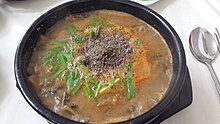|
Chueo-tang
Chueo-tang (Korean: 추어탕) or loach soup[1] is a Korean tang (soup) that prominently features pond loach, a freshwater fish.[2][3] The city of Namwon in southwestern South Korea is known for its version of the dish.[4][5][6] EtymologyChueo (추어; 鰍魚) is a nickname for pond loach, called mikkuraji (미꾸라지) in Korean. Tang (탕; 湯) means soup. History and traditionAs irrigated rice paddies are drained after chubun (autumnal equinox), chubby pond loaches, ready for hibernation, are easily caught in the ditches dug around paddy fields.[7] Chueo-tang (추어탕) is often a featured dish in banquets for the elderly.[7] In Hanyang (now Seoul) during the Joseon era, the guild of licensed panhandlers mandated that its members beg only for bap (cooked rice), not banchan (side dishes) or guk (soup).[7] (The practice was intended to maintain dignity and differentiate members from unlicensed beggars.) As an accompaniment to the rice, Panhandlers hunted pond loaches and made chueo-tang. They were also granted the exclusive rights to sell chueo-tang in the city.[7] The third-oldest operating restaurant in Seoul, Yonggeumok,[8] specializes in the Seoul style of the dish. In the Seoul style, the fish are served whole, and the soup base uses chili pepper flakes instead of gochujang.[9] PreparationPond loaches are boiled in water until very tender, and sieved to remove bones and skins.[10] The sieved flesh along with beef or chicken broth is then boiled again and seasoned with gochujang (chili paste), doenjang (soybean paste), grated ginger, and ground black pepper.[10] Vegetable ingredients include mung bean sprouts, Asian royal fern, scallions, napa cabbages, and mustard greens.[10] The soup is often served with ground chopi peppercorns, along with Korean mint leaves (in Yeongnam region) or perilla powder (in Honam region).[11] See alsoWikimedia Commons has media related to Chueotang.
References
|
||||||||||||||||||||||||||

